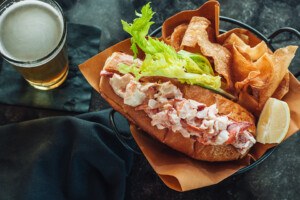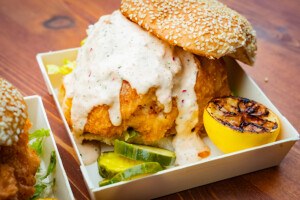Five Great New England Oktoberfest Beers to Start Drinking Now

Peak Organic has recently released its first ever Oktoberfest beer. Photo provided
In the Middle Ages, when airborne bacteria and pestilent flies were a common nuisance during the hot summer months—hence the pewter lids on traditional Keferloher mugs—German brewers began making a durable, extra strong lager that could withstand months of cold storage. That hop-forward beer, called a Märzenbier, was adopted as the official style for Munich’s Oktoberfest, a celebration which dates back to 1810.
Now, of course, Oktoberfest is the biggest beer blowout on the planet, with over six million annual visitors consuming nearly seven million liters of beer over the course of just 16 days. But outside of Munich, Märzens are facing a dilemma. According to Jack Hendler of Jack’s Abby—Framingham’s all-lager brewery—the robust, full-bodied beer is waning in popularity because of America’s infatuation with “extreme beers.”
“It’s funny because in Germany, anything that’s not light in color or under five percent ABV is considered an ‘extreme beer,”‘ Hendler says. “So, Oktoberfest beers are considered big and aggressive and very special. People in the general public really like the style, but if you talk to someone who calls themselves a ‘beer geek’ they’re put off because it’s too simple; it’s not 10 percent alcohol and 5,000 IBU’s.”
Even Hendler, who remains of fan of classic examples from Ayinger and Weihenstephaner, is nonetheless skeptical of German brewers who have sacrificed strength and malt levels over the past couple decades. So, how do you brew a Märzen tantalizing to American palates? Peak Organic’s Jon Cadoux says you have to find that delicate balance of “sweet maltiness, subtle toastiness, and enough hop character to lend the beer some structure.”
Fortunately, the zeal surrounding pumpkin ales has begin to tarnish and New England brewers are instead ushering in autumn with their own version of this German favorite. Here are five great local examples that’ll make you want to yell “O’ zapft is!”
1. Idle Hands Brocktoberfest
Alcohol by Volume: 5.6%
For their third annual Oktoberfest celebration at Atwood’s Tavern in Cambridge, Idle Hands will not only be serving bratwurst, red cabbage, and its Adelais unfiltered pilsner, but founder Christopher Tkach’s first stab at a traditional Märzen. Named Brocktoberfest (after Tkach’s son Brock who was born in February) Idle Hands combines Pilsner, Vienna, Caramunich, and Munich malts for a smooth, bread-y nose, with an addition of Magnum and Hallertau Mittlefruh hops that lend a spicy, floral counter. “Since our upgrade last year, we now have much more control over our fermentation temperatures, which has allowed us to produce authentic lagers,” Tkach says. “I’ve been a fan of German lagers for a long time—it’s sort of my second love behind Belgian beers. Brocktoberfest is designed to be a true fest bier, so much drier and with less caramel character than what many Americans consider an ‘Oktoberfest’ beer.'”
2. Peak Organic Hop Harvest Oktoberfest
Alcohol by Volume: 4.9%
For over a year, Peak Organic’s Jon Cadoux has been tinkering with a crisp, clean Oktoberfest beer brewed with Munich, Vienna, and Victory malt, but it wasn’t until he added a generous amount of Centennial, Chinook, and Simcoe hops during the flameout—which adds a lingering, grapefruit hoppiness—that he was finally willing to unveil it to the public. “We love Oktoberfest beers, but my thinking is, if you can’t improve upon a style, there’s not need to release it,” Cadoux says. “We loved our initial Oktoberfest recipe, but why release it when there’s already so many perfect German examples. We finally hit upon this recipe, which is almost a mix of an IPA and a classic Märzen. People just seem to love it because it has that aroma and front palate of classic American sea hop lusciousness to go along with a bone-dry finish, and the toastiness of a classic German Oktoberfest.”
3. Jack’s Abby Copper Legend
Alcohol by Volume:5.7%
“First of all, I love the Märzen style,” says Hendler. “And if you are going to brew lagers, you absolutely have to brew an Oktoberfest.” Copper Legend not only was Hendler’s first seasonal offering at Jack’s Abby, it was also the first specialty beer he ever attempted at his Framingham brewery. Now in its fourth year, Copper Legend is not only available in six-packs for the first time, it’s been refined to match Hendler’s ideal version of a Märzen. “I think there’s something to be said for a really approachable, full-flavored beer that’s not over the top,” Hendler says. “What we’ve done is try to get more traditional over the years using all German hops and malt. We started off quite strong at 6.5 percent ABV and dialed it down to 5.7 percent this year. You get this nice German malt quality, which I always think has a grape-like note to it, and a mellow Noble Hop character to help balance out a lot of the sweetness.”
4. Element Altoberfest
Alcohol by Volume: 8.35%
Element’s Daniel Kramer and Ben Anhalt have both been commercial brewers for a combined 52 years. So it seems to speak volumes that the first seasonal they chose to make when they struck out on their own is this Alt/Märzen mashup that’s become an annual highlight at their 4 BBL nanobrewery in Millers Falls. Fermented with a house ale yeast and hopped with an aggressive dosage of Santium pellets, Altoberfest has more in common with Imperial American versions such as Avery Kaiser than traditional German quaffers. Sure, you get those sticky toffee and burnt toast flavors from Vienna and Munich malts, but Altoberfest finishes with a punch of citrus and pine resin that is distinctively American in its approach.
5. Berkshire Brewing Company Oktoberfest Lager
Alcohol by Volume: 6.8%
Berkshire Brewing founder Gary Bogoff has long been a fixture in the Massachusetts brewing scene, thanks to consistently great offerings like his Oktoberfest Lager, which he introduced in 1996. But because the backbreaking process involved in brewing his Märzen had taken such “a psychological toll” on his brewing team, Bogoff gave his team a reprieve in 2013. “My backside is still sore over the amount of flak I got over that decision,” Bogoff says. “It’s an extremely difficult beer to make because we brew it in the original fashion. Every time we made it, there seemed to be some little glitch that had everyone wigged out, so I gave everyone a year off to regain their confidence.” Now Bogoff’s Oktoberfest is back and charming its fans with maltier undertones and an earthy addition of Hersbrucker and Northern Brewer hops. “From a pragmatic standpoint, our Oktoberfest holds up to the best of them,” Bogoff says. “I think we’ve finally overcome the beast.”


